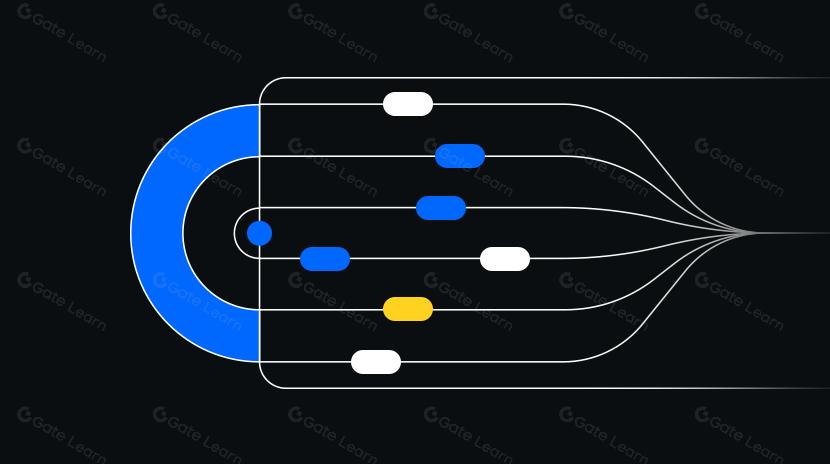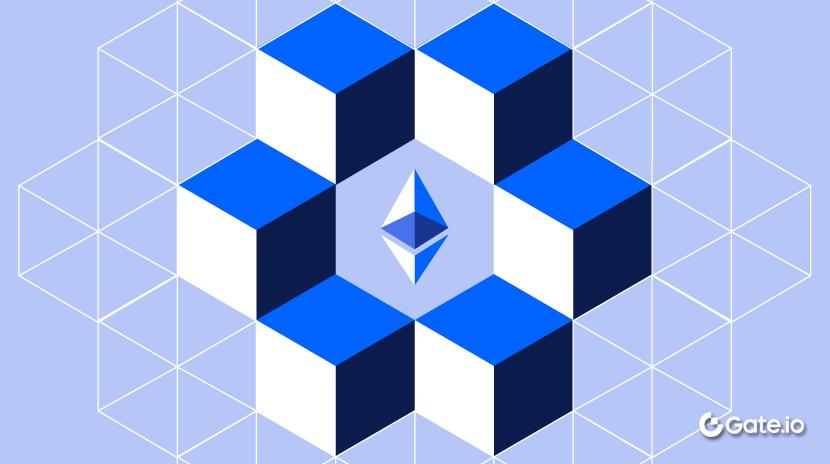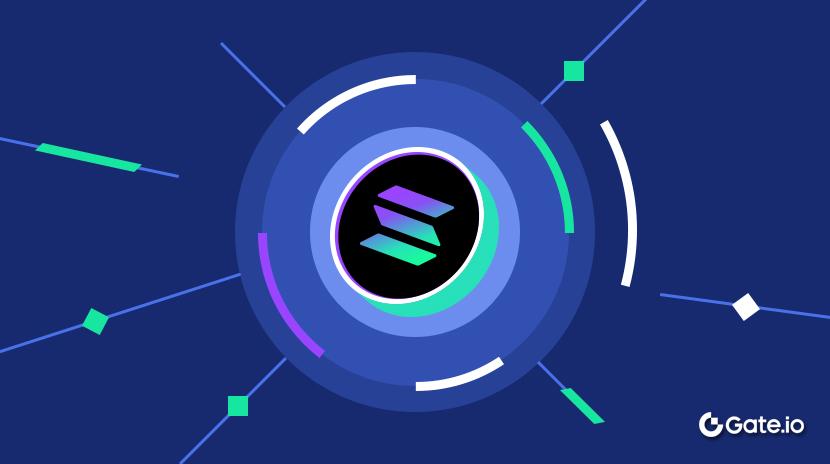Дослідження Gate: Hyperliquid стикається з атакою маніпулювання, Вайомінг запускає перший стейблкоін, виданий державою США WYST
Абстрактний
- BTC показав нестабільну висхідну тенденцію на цьому тижні, досягнувши піку у $88,757.
- Гіперрідина зазнала маніпуляційної атаки, підсилюючи зростаючу кризу довіри.
- Вайомінґ планує запустити свою стейблкоін, WYST, у липні.
- Розробники Ethereum підготували пропозицію EIP-7917.
- Ставки за позичання Aave впали до 4%, відображаючи зростання ризикованого настрою на криптовалютному ринку.
- Загальна вартість, заблокована Berachain (TVL), перевищила 3,4 мільярда доларів, і Infrared виступив ключовим катализатором зростання.
- Протокол DeFi Abracadabra постраждав від експлуатації на 13 мільйонів доларів.
Аналіз ринку
Огляд та висновки
- BTC- Цього тижня BTC показав нестабільну зростаючу тенденцію, з поточною ціною, що коливається навколо $87,500. Короткостроковий рівень підтримки знаходиться близько $85,000, з більшою підтримкою, розташованою навколо $82,500. На позитивній стороні, негайний опір лежить між $87,500 і $88,000. Якщо BTC успішно прорветься через цю зону, він може подальше протестувати діапазон опору від $89,500 до $90,000. Тим часом загальний обсяг торгів на ринку залишався помірним, з випадковими місцевими скачками, яким бракувало тривалого імпульсу. Як бик і ведмідь залишалися обережні, що свідчить про те, що ймовірно, BTC залишиться в фазі консолідації в короткостроковій перспективі. [1]

- ETHНа цьому тижні ETH слідував схожому шаблону, зберігаючи волатильний вгорнявий тренд з поточною ціною приблизно $2,035. Короткотермінова ключова підтримка знаходиться на рівні $1,980, де попередні відступи знайшли ефективну підтримку. Міцна підтримка розміщена приблизно на рівні $1,920. Зверху чітка опір знаходиться між $2,050 та $2,080. Успішний вибій та стабілізація вище цього діапазону може призвести до подальшого тесту рівня $2,150. Щодо ринкової активності, ETH виявив помірний обсяг торгів на цьому тижні, з випадковими скачками, але без стійкого тренду, що свідчить про те, що ймовірно ETH продовжить коливатися в цьому діапазоні у найближчий час.

- монети—— Протягом останніх 7 днів альткоїн ринок пережив відновлення, загальні прибутки перевершили показники минулого тижня. Три найбільш прибуткові сектори були Cross-chain Communication (приблизно на 45%), AI Meme (зросли на близько 14.7%) і Liquid Staking Tokens (збільшилися приблизно на 9.5%) [3]
- Ринок опціонів—— За даними на 8:00 ранку (UTC+8) 27 березня 2025 року загальний відкритий інтерес до опціонів BTC становив 36,517 мільярдів доларів, що свідчить про невелике зростання порівняно з минулотижневими 35,651 мільярдами доларів. Зокрема, номінальна вартість опціонів, які закінчуються 28 березня, зросла до 13,747 мільярдів доларів. [4]
- Макро-дані —— У вечірній час 25 березня Сполучені Штати повідомили про зниження індексу споживчої довіри до 92,9, що вище очікуваного значення 94,5, що свідчить про зростаючі обурення щодо економічних перспектив. [5]
- Стейблкоїни —— Цього тижня загальна ринкова капіталізація стейблкоїнов зменшилася на 3,47%, впавши до $222,4 мільярда, відображаючи значні відтоки капіталу. [6]
- Вартість газу Протягом останніх 7 днів середня комісія за газ Ethereum зросла до 0,52 Gwei, тоді як загальна активність мережі зафіксувала невелике зниження. [7]
Тенденції концепцій
Цього тижня BTC коливався між $84,000 та $89,000, тоді як виступ різних секторів альткоїнів був змішаним. За даними CoinGecko, топ-3 сектори з найкращими показниками були міжланцюжкова комунікація, штучний інтелект Meme та рідкий стейкінг токени, чиї ринкові капіталізації за 7 днів збільшилися приблизно на 43,9%, 14,7% та 9,5% відповідно. [8]
Міжланцюжкова комунікаціяСектор цілиться на технології та практики взаємодії між різними мережами блокчейнів. Мета полягає в полегшенні безшовного переносу та взаємодії активів, даних та інформації між різнорідними ланцюжками за допомогою мостових протоколів, механізмів ретрансляції та інших рішень. Розбиваючи блокчейн-сілоси, він сприяє інтеграції та спільному розвитку екосистем блокчейнів.
Сектор міжланцюжкової комунікації зріс на 43.9% за останні 7 днів, з ринковою капіталізацією, що досягла $3.033 мільярда і обсягом торгів на 24 години в розмірі $103 мільйони. У цьому секторі токен ZETA очолив приріст, піднявшись на 61.7% протягом останніх 7 днів. [9]
Штучний інтелект Meme—— Цей сектор об'єднує штучний інтелект (AI) з культурою інтернет-мемів, використовуючи AI для генерації, редагування та поширення гумористичного, сатиричного або культурно резонансного контенту мемів. Він створює новий та захоплюючий цифровий культурний досвід, поєднуючи передову технологію AI з креативними інтернет-трендами.
Сектор штучних інтелектів Meme збільшився на 14,7% за останні 7 днів, з ринковою капіталізацією у розмірі 235 мільйонів доларів і обсягом торгів на 24 години у розмірі 622 мільйони доларів. Серед токенів у цьому секторі Fartcoin зафіксував зростання на 51,3% протягом останніх 7 днів. [10]
Токенізація рідинного стейкінгу—— Цей сектор представляє токенізовані версії стейкнутих активів, які можна торгувати в додатках DeFi, отримуючи винагороду за стейкінг. Наприклад, Lido Staked Ether (stETH) - це токен, що представляє стейкнутий Ethereum.
Ринкова капіталізація сектору токенів ліквідного стейкінгу зросла на 9,5% на цьому тижні, досягнувши приблизно $33,9 мільярда, з обсягом торгів на 24 години у розмірі $221 мільйон. У межах цього сектору токен LBGT зріс на 116,4% за останні 7 днів. [11]
Топ виконавці
За даними CoinGecko, найкращими токенами за останні 7 днів є наступні: [12]

BBERA (Berachain) —— Прибуток за 7 днів становить приблизно 27,0%, з ринковою капіталізацією у розмірі 846 мільйонів доларів.
Berachain, запущений наприкінці 2021 року, є EVM-сумісним блокчейном першого рівня, спрямованим на DeFi, побудованим на Cosmos SDK та використовуючи інноваційний механізм згоди Proof of Liquidity (PoL). Походження проекту досить унікальне, відслідковуючи шлях до серії NFT Bong Bears, запущеної в серпні 2021 року, яка пізніше породила кілька пов'язаних колекцій NFT з ведмежатами.
Протягом останніх 7 днів зростання ціни Berachain (BERA) в основному було спричинене швидким зростанням її екосистеми, покращенням ринкового настрою та офіційним запуском її механізму Proof of Liquidity (PoL). Як блокчейн, сумісний з EVM, TVL та активність користувачів Berachain показали значний ріст, тоді як механізм PoL стимулює надання ліквідності, підвищуючи довіру інвесторів. Ці сприятливі події підштовхнули швидке короткострокове зростання ціни BERA.
CRO (Cronos) —— 7-денний приріст близько 25,3%, з коловим ринковим капіталізацією у розмірі 2,76 мільярда доларів.
Cronos (CRO) - це власна криптовалюта блокчейну Crypto.com та ланцюга Cronos EVM. Відомий тим, що використовує технологію блокчейну, сумісну з Ethereum, побудовану на Cosmos SDK, Cronos EVM дозволяє розробникам безперешкодно мігрувати додатки з інших блокчейнів, дозволяючи користувачам здійснювати децентралізовані транзакції без необхідності дозволу або нагляду центральної влади.
Нещодавнє зростання Cronos (CRO) було головним чинником оголошення стратегічних партнерств і наближаються основних оновлень мережі. Зокрема, Trump Media & Technology Group (TMTG) оголосила про співпрацю у розробці Truth.Fi, фонду ETF, який включає Bitcoin, Cronos та інші основні криптовалютні активи. Крім того, очікується покращення головної мережі zkEVM Cronos, заплановане на березень 2025 року, що збільшило ринкові очікування. Це оновлення очікується поліпшити ефективність мережі та користувацький досвід за допомогою технології розумного одного входу в обліковий запис та технології шлюза з нульовими знаннями. Ці розвитки значно підвищили ринковий настрій, призвели до зростання торговельного обсягу та залучення хвилі інвесторів та спекулянтів, що призвело до короткострокового стрибка ціни CRO. [14]
S (Sonic (попередньо FTM)) —— Прибуток за 7 днів становить приблизно 14,6%, із обіговою ринковою капіталізацією в розмірі $1,959 мільярдів.
Sonic - це сумісний з EVM блокчейн першого рівня, призначений для надання надійної інфраструктури та стимулів для додатків DeFi. Мережа може похвалитися високою пропускною здатністю в 10 000 TPS та підтвердженням транзакцій за декілька субсекунд. Крім того, Sonic Gateway - це безпечний міст, що з'єднує Ethereum, додатково підвищує ліквідність та безпеку активів.
Нещодавно запуск Sonic Pay та розгортання декількох платформ DeFi, таких як AAVE, збільшили його TVL до 800 мільйонів доларів, привертаючи більше уваги інвесторів до його функціональності та вартості. Це збільшене визнання призвело до зростання цін на токени.
Щотижневі прожекції
Огляд гарячої теми
Розробники Ethereum підготували пропозицію EIP-7917 для вирішення невизначеності на виборах пропозиційників
27 березня 2025 року розробники ядра Ethereum linoscope та JustinDrake підготували пропозицію EIP-7917. Ця пропозиція спрямована на вирішення невизначеності в поточному процесі виборів пропозицій, спричиненої коливаннями ефективних балансів валідаторів за допомогою введення визначального механізму попереднього перегляду пропонентів. Цей підхід передбачає покращення безпеки системи, спрощення впровадження протоколів on-chain і збереження сумісності з попередніми версіями та масштабованість.
Якщо буде прийнято, EIP-7917 ймовірно значно покращить передбачуваність та безпеку процесу вибору пропонента. Завдяки попередньому обчисленню перегляду пропонента, пропозиція може пом'якшити ризики, пов'язані з коливаннями ефективного балансу, забезпечуючи більш стабільну та надійну мережеву діяльність. Це покращення може підвищити довіру як до операторів валідаторів, так і до користувачів. Широка галузь блокчейн-індустрії також може скористатися покращеною безпекою та ефективністю, які приніс би EIP-7917 Ethereum.
Як один із найважливіших громадських блокчейнів у криптосфері, поліпшення Ethereum часто встановлюють стандарт для інших проєктів. Ця пропозиція підкреслює критичну роль громадського управління в нинішньому розвитку громадських блокчейнів. [16]
Вайомінг запустить стейблкоін WYST у липні
Уайомінґ планує запустити свій стейблкоїн WYST у липні 2025 року, зробивши його першим штатом США, що випускає стейблкоїн, повністю підтриманий активами фіату. Вартість WYST буде підтримуватися цінними паперами Міністерства фінансів США, готівкою та угодами зворотного викупу, забезпечуючи мінімальний капіталізаційний рівень на рівні 102%. Штат планує використовувати відсотки, отримані від цих резервних активів, для фінансування освітніх та інфраструктурних проєктів. Наразі Уайомінґ розглядає блокчейн-платформи, такі як Solana, Ethereum та Polygon, для розгортання та проведення токена.
Запуск WYST є значним кроком для місцевих урядів США у входженні в галузь криптовалют, що потенційно відкриває шлях для інших штатів - а навіть федерального уряду - досліджувати власні стейблкоїни. Оскільки WYST буде підтримуватися фіатними активами та підлягатиме чітким вимогам капіталізації, очікується, що він запропонує більшу стабільність та відповідність регулятивним вимогам порівняно з існуючими стейблкоїнами, такими як USDT та USDC. Ця ініціатива може привернути традиційних інституційних інвесторів на ринок криптовалют та сприяти використанню технології блокчейну у сфері державних фінансів.
Однак успіх WYST в кінцевому підсумку залежатиме від таких факторів, як прийняття на ринку, підтримка обміну та конкурентоспроможність по відношенню до існуючих стабільних монет. Додатково, якщо WYST вибере працювати на Solana, Ethereum або Polygon, це може подальше покращити екосистеми цих блокчейнів, сприяючи позитивним ринковим ефектам.
Гіперрідке обличчя маніпуляційний напад, криза довіри загострюється
26 березня трейдер маніпулював ринком JELLYJELLY на Hyperliquid, відкривши коротку позицію на суму 6 000 000 доларів США і підвищивши ціни, що призвело до примусових ліквідацій, що вплинули на ліквідність пулу HLP. Незважаючи на видалення контракту Hyperliquid і обіцянку компенсувати користувачів, довіра швидко погіршилася, що призвело до виведення 140 мільйонів доларів США USDC з платформи.
Подія викрила недоліки практик управління ризиками Hyperliquid щодо обробки активів з низькою ліквідністю. Хоча рішення про вилучення контракту та надання компенсації може бути запобігло миттєвому фінансовому злому, це викликало сумніви щодо зобов'язань платформи до децентралізованого управління, особливо з урахуванням того, що її валідаторні вузли переважно контролюються Hyper Foundation. Довіра користувачів постраждала, а вивід коштів підкреслив виклики для довгострокової стабільності. Централізовані біржі можуть використати нагоду, щоб привернути користувачів, особливо в умовах пошкодженого репутації Hyperliquid.
Інші децентралізовані біржі (DEXs) також можуть взяти на замітку цей інцидент, покращуючи своє управління ризиками та рамки управління. Ця подія підкреслює виклики, з якими стикаються DEXs у вирішенні ринкового маніпулювання та забезпеченні стабільності платформи, що потенційно може підштовхнути галузь до покращення оцінки ризиків та механізмів управління. Крім того, регулятори можуть посилити контроль за DEXs, що змусить галузь прийняти більш прозорі рамки управління.
Інцидент безпеки
Протокол DeFi Абракадабра став жертвою експлуатації на $13 мільйонів
25 березня 2025 року DeFi протокол Абракадабра зазнав серйозної атаки, в результаті чого було втрачено приблизно 13 мільйонів доларів (близько 6 260 ETH). Атака здобула широку увагу з боку криптоспільноти і знову підкреслила виклики, з якими стикаються DeFi протоколи у забезпеченні безпеки смарт-контрактів. Атакувальник використав помилку округлення при розрахунку застави та боргу, що дозволило йому вибити велику кількість стабільних монет MIM, які були швидко обміняні на ETH або USDT для уникнення відстеження та переказу коштів.
Офіційна команда Abracadabra визнала інцидент і наразі співпрацює з фірмами з безпеки, такими як PeckShield та CertiK, щоб відстежити вкрадені кошти та спробувати заморозити деякі активи. Команда також вирішує вразливість контракту та ймовірно покращить процедури аудиту, оптимізує механізми точної обробки та розгляне можливість впровадження багатофакторної перевірки, щоб запобігти подібним атакам у майбутньому. Хоча протоколи DeFi сприяють фінансовій інновації, безпека смарт-контрактів залишається невідворотним ризиком, що вимагає постійної бджілі. [19]
Виділення проекту
Nillion Alpha Mainnet запускається
24 березня мережа обчислень, орієнтованих на конфіденційність, Nillion, оголосила про офіційний запуск свого основного Alpha, що є важливим кроком у розвитку технології розподіленого конфіденційного обчислення. Nillion фокусується на захисті конфіденційності даних та безпечних обчислень, дозволяючи багатосторонні обчислення та співпрацю з даними між сутностями без розкриття чутливої інформації. Запуск цієї основної мережі в першу чергу спрямований на розробників, надаючи інфраструктуру, необхідну для побудови розподілених додатків (dApps) на основі протоколу Nillion та сприяючи захисту конфіденційності даних та співпраці між ланцюгами.
Як важлива частина інфраструктури Web3, обчислення конфіденційності залучає все більше уваги. Запуск основної мережі Nillion Alpha не лише впливає на свіжий поштовх у секторі обчислення конфіденційності, але також пропонує високоефективне, сумісне рішення для сценаріїв високого зростання, таких як безпека даних та тренування конфіденційності штучного інтелекту. Цей розвиток передбачає залучення більше розробників та капіталу в майбутньому.
Висновки даних
Ставки за позиками Aave складають 4%, відображаючи зростаючу відмову від ризику на криптовалютному ринку
Дані від Aave, провідної децентралізованої платформи кредитування, свідчать про ослаблення довіри ринку. Наразі річні процентні ставки по кредитах для основних стейблкоінов, таких як USDT та USDC, впали до близько 4%, що значно менше, ніж рівень 10%+, спостережений під час бичих ринків, що вказує на зниження апетиту до ризику і зростання ухильності до ризику в крипторинку. Тим часом, ціна Bitcoin коливалася між $76,000 та $88,000 з березня, не маючи чіткого каталізатора, що обмежило його вищу динаміку.
Як важливий показник активності капіталу на ланцюжку, зниження ставок Aave відображає охолодження відносин до ризикованої торгівлі. Слабкий попит на позику та стримливий підхід капіталу призвели до зниження ринкової активності та обмеження волатильності цін.
У цілому, продовжуване зниження процентних ставок з позики Aave стало провідним індикатором настроїв ринку. Без напливу нового капіталу або значущих позитивних катализаторів, ймовірно, що Біткоін залишиться в фазі консолідації на короткий термін, оскільки ринок входить в період відновлення довіри та ліквідності. [21]
TVL Berachain перевищує $3.4 мільярда, Інфрачервоне стає ключовим драйвером зростання
Нове високопродуктивне блокчейн-середовище Layer 1 Berachain недавно перевищило 3,5 мільярда доларів у загальному обсязі заблокованих коштів (TVL), встановивши новий історичний максимум та демонструючи потужний наріст у своєму стрімкорозширюваному екосистемі. Одним із основних драйверів цього зростання TVL стала офіційна публікація системи “Proof-of-Liquidity” (PoL) Berachain 24 березня, що означило початок першої фази його управління на ланцюжку. Механізм PoL не лише зміцнює стимули для стейкінгу, але й сприяє рециклінгу капіталу в екосистемі, що подальше прискорює приплив ліквідності.
Інфрачервоне, протокол рідкісного укладання, відігравало ключову роль у цьому зростанні, з його TVL перевищив $2.3 мільярдів — що становить понад 60% від загального TVL Berachain — і підвищився на 20% всього за 7 днів. Привабливість Інфрачервоного полягає в його високому потенціалі доходності, його тісному інтеграції з власними активами Berachain та зростаючому ринковому інтересу до сектору LSD (рідкісні похідні укладання), що робить його ключовою точкою входу для розгортання капіталу.
Наразі TVL Berachain залишається високо концентрованим, з основними протоколами, які стимулюють більшість зростання. Для диверсифікації та забезпечення сталого зростання Berachain потрібно буде ввести більше фундаментальної інфраструктури, такої як DEXs та платформи кредитування. З запуском головної мережі та очікуванням роздачі токенів, Berachain продовжує проявляти сильний привабливість капіталу, але його довгострокове утримання та екосистемна липучість залишаються областями для постійного спостереження.

Дані Bitcoin On-Chain показують, що короткострокові тримачі під тиском, довгострокові тримачі домінують у прибутках
Згідно з даними Glassnode, витрати серед тривалих утримувачів (LTHs) та короткострокових утримувачів (STHs) показали чітку розбіжність на поточному ринку. Майже всі реалізовані втрати походять від короткострокових утримувачів, які купили за вищими цінами під час останніх ринкових циклів. При BTC, який коливається навколо 86 000 доларів при частих коливаннях цін, ці утримувачі більш схильні до панічної продажу та виходу під час спадів. Натомість більшість прибуткових продажів очолюються тривалими утримувачами, які придбали свої BTC за значно нижчими цінами та залишаються в сильній прибутковій позиції незважаючи на ринкову волатильність, що надає їм більшу гнучкість у продажу.
Загалом, BTC зараз перебуває в перехідній фазі, де власники короткострокових позицій зіштовхуються з продажовим тиском, тоді як власники довгострокових позицій реалізовують прибуток. Якщо ця тенденція триватиме, ринок може увійти в фазу консолідації, яку приведе розподіл капіталу. Майбутній результат буде залежати від того, чи продовжиться притік свіжого капіталу і чи покращаться макроекономічні умови.

Ринкові можливості
Проект роздач монет
OneFootball
OneFootball - це футбольна медіа-компанія з головним офісом у Берліні, Німеччина, заснована в 2008 році. Компанія запустила OneFootball Labs, платформу на основі блокчейну, яка дозволяє клубам, лігам, федераціям та гравцям випускати цифрові токени та підвищувати залученість вболівальників.
Команда OneFootball підтвердила плани щодо запуску власного токену OFC, що означає, що учасники, які зараз беруть участь в Points Farming, можуть бути відправними для майбутніх винагород за аеродроп токенів. Сезон 2 активності офіційно стартував, де користувачі можуть накопичувати бали, виконуючи завдання, що потенційно дасть право на майбутній аеродроп токенів OFC.
Як прийняти участь:
- Відвідайте сторінку події та створіть обліковий запис.
- Підключіть свій гаманець та виконуйте завдання, щоб заробляти бали
Примітка:
Програма роздачі та методи участі можуть змінюватися. Користувачам рекомендується слідкувати за офіційними каналами OneFootball для отримання останніх оновлень. Крім того, користувачам слід бути обережними, усвідомлювати потенційні ризики та проводити ретельні дослідження перед участю. Gate.io не гарантує розподіл майбутніх винагород за роздачу.
Щотижневий звіт про збір коштів
Цього тижня відбулося кілька успішних раундів залучення коштів у сферах інфраструктури, DeFi та інших секторах. За даними RootData, 10 проєктів залучили понад 70 мільйонів доларів між 21 та 27 березня.

Ось три найкращі події зі збору коштів:[25]
Tabitпідняв $40 мільйонів 24 березня в Bitcoin, який буде служити резервами для традиційного страхування та перестрахування. Як страховик, що діє під контролем влади Барбадосу, Tabit твердить, що є першим у світі відповідним ризиковим укладачем, який використовує резерви Bitcoin для традиційних полісів, виражених в USD.
Наразі Tabit пропонує традиційні страхові продукти, включаючи покриття D&O, вводячи криптозабезпечені інновації в традиційне страхування з резервами Bitcoin та USD врегулюванням. Цей підхід спрямований на привертання криптокомпаній, проєктів Web3 та DAO, особливо в високоризикових областях, які не обслуговуються традиційним банківським сектором.
Протокол хронікиsecured $12 million in seed funding on March 25, led by Strobe Ventures and 6th Man Ventures. Як перший оракул Ethereum, створений колишніми членами команди MakerDAO, Chronicle дозволяє блокчейнам надсилати та отримувати дані поза ланцюжком подій, схоже на те, як телефони підключаються до зовнішніх джерел даних.
Chronicle також надає інфраструктуру для токенізованих активів, обслуговуючи як сектор DeFi, так і сектор RWA з його перевіреним активним оракулом. Фінансування підтримає розробку продукту та дослідження.
Fragmetricзбільшив $5 мільйонів стратегічного фінансування 24 березня, очоливши RockawayX та Robot Ventures, щоб розширити функціонал і прискорити розробку платформи переставляння. Проект фокусується на модульній блокчейн інфраструктурі, що підтримує інтеграцію між ланцюжками для Rollups, додатків у ланцюжку та децентралізованого штучного інтелекту.
Послідовний розвиток fragAsset зміцнює позицію Fragmetric в просторі «модульного + перерозподілу», що потенційно може розширитися на багатоланцюгове децентралізоване фінансування, валідацію безпеки та децентралізоване обчислення. У разі успіху Fragmetric може виступити як сильний конкурент EigenLayer у секторі перерозподілу.
Що дивитися наступного тижня
Розблокування токенів
Згідно з даними Tokenomist, на наступний тиждень (28 березня - 3 квітня 2025 року) заплановано кілька великих подій з розблокування токенів, загальна вартість яких перевищує 224 мільйони доларів.[26]

Тут топ-3 розблокувань:
SUI розблокує близько 64,19 мільйона токенів 1 квітня 2025 року о 12:00 UTC, що представляє 2,03% відтоків та оцінюється приблизно в $170 мільйонів. З недавнім щоденним обсягом торгів SUI близько $850 мільйонів, ця розблокування може мати мінімальний вплив.
OP29 близько 31,34 мільйонів токенів буде розблоковано 31 березня 2025 року о 12:00 UTC, що становить 1,92% від його обігового запасу і оцінюється приблизно в 28,62 мільйона доларів. З урахуванням недавнього щоденного обсягу торгів OP в 100 мільйонів доларів, вплив цього розблокування повинен бути обмеженим.
ZETAу квітні 2025 року о 12:00 UTC буде розблоковано приблизно 44,26 мільйонів токенів, що становить 6,05% від загального обсягу та має вартість близько 15,38 мільйонів доларів. Оскільки останній щоденний обсяг торгів ZETA становить приблизно 200 мільйонів доларів, цей розблокування очікується мати мінімальний вплив.
Криптокалендар
Низка значущих подій наступного тижня (28 березня - 3 квітня 2025 року) можуть суттєво позначитися на ринку криптовалют, глобальній економіці та енергетичному секторі. 28 березня Taiko запустить оновлення Pacaya, вводячи значний прогрес з механізмом попереднього підтвердження [27], тоді як США випустять Індекс цін на базове споживче виробництво лютого (річний) [29]. 31 березня означає офіційний початок конституційного голосування CIP-1694 Cardano[28]. 1 квітня США оголосять Індекс PMI виробництва ISM за березень [30], а 2 квітня - звіт про зміну зайнятості ADP за березень (в тисячах) [31]. Нарешті, 3 квітня США опублікують початкові дані про подання вимог на отримання допомоги по безробіттю за тиждень, що закінчується 29 березня (в тисячах) [32].

References:
- Gate.https://www.gate.io/trade/BTC_USDT
- Gate.io,https://www.gate.io/trade/ETH_USDT
- Coingecko,https://www.coingecko.com/en/categories
- монета,https://www.coinglass.com/pro/options/OIExpiry
- Cryptocraft,https://www.cryptocraft.com/calendar?day=mar25.2025
- Defillama,https://defillama.com/stablecoins
- Ethscan,https://etherscan.io/gastracker#chart_gasprice
- Coingecko,https://www.coingecko.com/uk/categories
- Coingecko,https://www.coingecko.com/categories/cross-chain-communication
- Coingecko,https://www.coingecko.com/categories/ai-meme-coins
- Coingecko,https://www.coingecko.com/categories/liquid-staking-tokens
- Coingecko,https://www.coingecko.com
- Gate.io,https://www.gate.io/price/berachain-bera
- Gate.io,https://www.gate.io/price/cronos-cro
- Gate.io,https://www.gate.io/price/sonic-s
- Ethereum,https://eips.ethereum.org/EIPS/eip-7917
- STC,https://stabletoken.notion.site/
- Попередження,https://foresightnews.pro/article/detail/81076
- X,https://x.com/MIM_Spell/status/1904535586532180434
- X,https://x.com/nillionnetwork/status/1904157582203207738
- Aavescan,https://aavescan.com
- DefiLlama,https://defillama.com/chain/Berachain?groupBy=cumulative&volume=true&tvl=false
- Glassnode,https://studio.glassnode.com/charts/indicators.RealizedProfitLossLthSthRelative?a=BTC&mScl=lin&pScl=lin&resolution=24h&s=1231718400&u=1742860800&zoom=
- OneFootball,https://club.onefootball.com/join
- Rootdata,https://www.rootdata.com/fundraising
- Tokenomist,https://tokenomist.ai/unlocks
- X,https://x.com/alethiataiko/status/1904079368155980233
- X,https://x.com/Cardano_CF
- Jin10,https://rili.jin10.com/
- Jin10,https://rili.jin10.com/
- Jin10,https://rili.jin10.com/
- Jin10,https://rili.jin10.com/
Дослідження Gate
Дослідження Gate - це комплексна платформа для дослідження блокчейну та криптовалют, яка надає глибокий контент. Це включає технічний аналіз, гарячі теми, огляди ринку, дослідження галузі, прогнози тенденцій та аналіз макроекономічної політики.
Клацнітьтутвідвідати зараз
Відмова від відповідальності
Інвестування на ринку криптовалют пов'язано з високим ризиком, тому рекомендується користувачам проводити незалежне дослідження та повністю розуміти природу активів і продуктів, які вони придбовують, перед тим як робити будь-які інвестиційні рішення. Gate.io не несе відповідальності за будь-які збитки чи шкоду, заподіяну такими інвестиційними рішеннями.
Пов’язані статті

Як провести власне дослідження (DYOR)?

Дослідження 8 основних агрегаторів DEX: Двигуни, що забезпечують ефективність та ліквідність на крипторинку

Як поставити ETH?

Що таке Технічний аналіз?

Що таке фундаментальний аналіз?
